Please Azure Arc Give me a Kubernetes Cluster
Hello there!
It’s been longer than planned ^^, sorry about that. So today, I propose a look at Azure Arc Enabled Kubernetes. I wanted to have a look at It since, well, forever, but always lacked time. Now we are here at last.
The agenda:
- An overview of Azure Arc and the architecture regarding Arc Enabled Kubernetes.
- the on boarding process.
- Arc-enabled Kubernetes from the Azure Ops Point of View.
There are really a lot of others stuff to discuss, but for a first article, It will definitely be enough.
1. Overview of Azure Arc Enabled Kubernetes architecture
As the title implies, let’s start with a little bit of architecture. Even before that, let’s talk about Azure Arc.
Azure Arc is not only one product, but more of a family of product. In this family, one aim: to ease hybridation and specifically operations in multi-cloud environment. Known members of the family are
- Azure Arc Enabled Server
- Azure Arc Enabled Kubernetes on which this article is about
- Azure Arc enabled Data Services
and others.
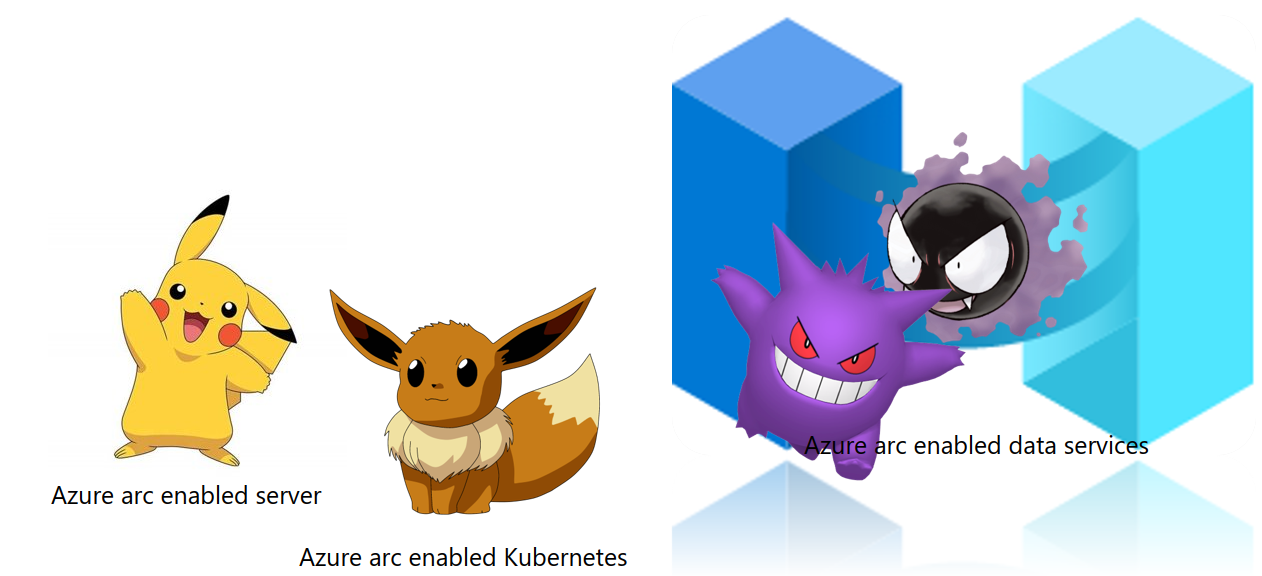
Let’s consider a Kubernetes cluster. This cluster could live anywhere, that’s not relevant for now. When we transform this cluster to an Arc Enabled Kubernetes cluster, a logical object, representing It in Azure, is created.
On the Cluster actual location, the cluster can be managed “as usual”, with native tools, such as kubectl, helm or even with gitOps tooling.
But because It exists in the Azure plane, It can also be managed in some ways in Azure, with Azure tools.

Now we mentioned a little bit of architecture, so how does It work inside this Arc Enabled cluster?
Very simply, there is an agent, the Arc enabled Kubernetes Agent, which pushes and pulls informations to and from the Azure plane.
Once the cluster is onboarded, the agent becomes responsible of updating the state of the cluster against its state in Azure. When an Azure Ops change the configuration on the Azure side, the agent get the desired state and, if required, pulls container images from Azure container registry.
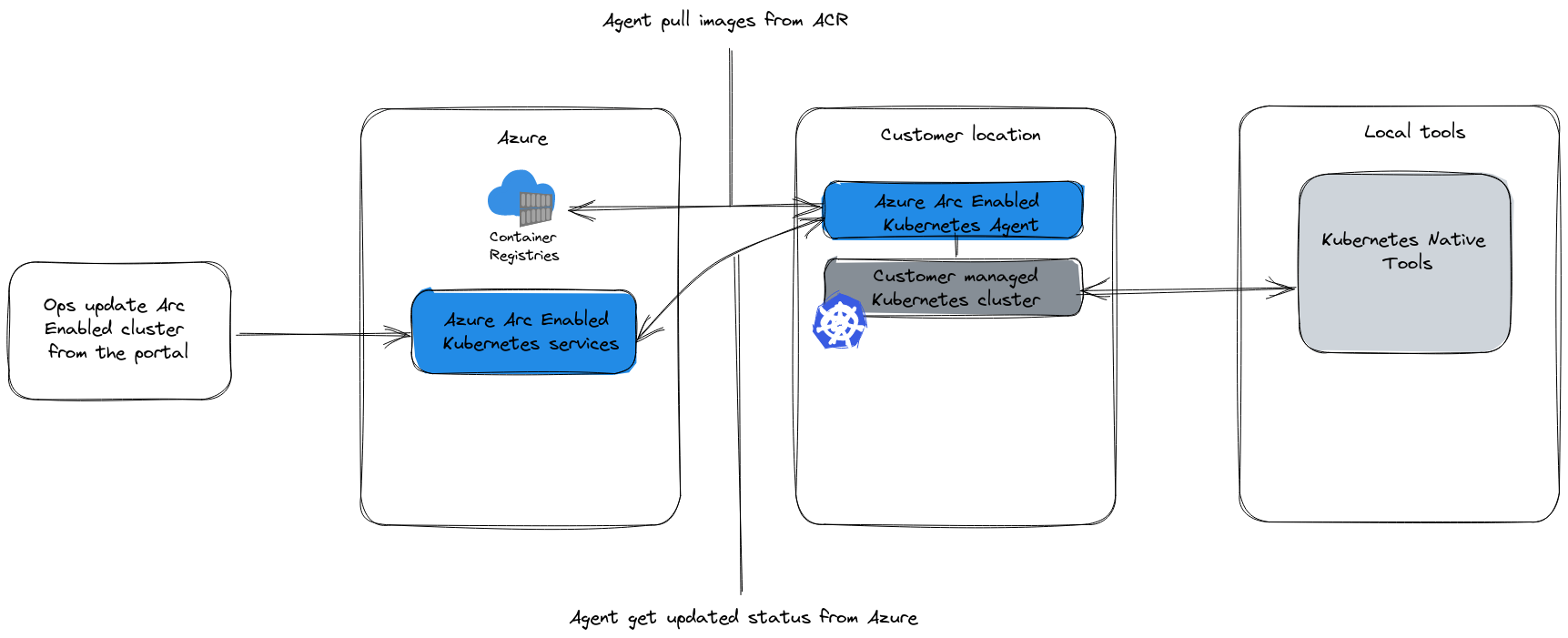
the main advantage is this one way connection, only ever initiated from the Cluster side. An Arc enabled Kubernetes cluster is never accessed from the Azure portal. On the other hand, It requires outbound connectivity to Azure.
The agent has different state in its lifecycle that are summarize in the table following:
| Status | Description |
|---|---|
| Connecting | The Azure Arc-enabled Kubernetes resource has been created in Azure, but the service hasn’t received the agent heartbeat yet. |
| Connected | The Azure Arc-enabled Kubernetes service received an agent heartbeat within the previous 15 minutes. |
| Offline | The Azure Arc-enabled Kubernetes resource was previously connected, but the service hasn’t received any agent heartbeat for 15 minutes. |
| Expired | The managed identity certificate of the cluster has expired. In this state, Azure Arc features will no longer work on the cluster. For more information on how to address expired Azure Arc-enabled Kubernetes resources. |
And that’s about all for the architecture concepts. There’s more regarding the outbound traffic, but we’ll detail that in the onboarding process.
2. On Boarding Kubernetes to Azure Arc
As discussed, there is really one element only in the Arc Architecture for Kubernetes Cluster, and this is the Azure Arc Enabled Cluster Agent.
To deploy this agent and initiate the on boarding process, we need the following prerequisites:
- the
kubectlcli installed - on the server to on board, cluster-admin access
- az cli with
connectedk8sextension - helm
- and outbound connectivity
Also, not specified on the documentation, if the cluster to onboard is an EKS or a GKE, it’s useful to have aws cli or gcloud cli. Similarly to the way we get credentials with az cli for AKS cluster, we can use those other clouds cli to get the creds.
About the kubectl cli, It should be configured so that the config file point to the cluster to onboard.
About the az cli, an authenticated session is required, with the extension connectedk8s for the onboarding.
About the outbound connectivity to Azure, because there is no easy way to allow only IPs to be reach, there is a list of fqdns required to allow the connectivity of the cluster:
| Endpoint | Description |
|---|---|
| https://management.azure.com (for Azure Cloud), https://management.usgovcloudapi.net (for Azure US Government) | Required for the agent to connect to Azure and register the cluster. |
https://region.dp.kubernetesconfiguration.azure.com (for Azure Cloud), https://region.dp.kubernetesconfiguration.azure.us (for Azure US Government) |
Data plane endpoint for the agent to push status and fetch configuration information. |
https://login.microsoftonline.com, https://region.login.microsoft.com, login.windows.net (for Azure Cloud), https://login.microsoftonline.us, region.login.microsoftonline.us (for Azure US Government) |
Required to fetch and update Azure Resource Manager tokens. |
| https://mcr.microsoft.com, https://*.data.mcr.microsoft.com | Required to pull container images for Azure Arc agents. |
| https://gbl.his.arc.azure.com (for Azure Cloud), https://gbl.his.arc.azure.us (for Azure US Government) | Required to get the regional endpoint for pulling system-assigned Managed Identity certificates. |
| https://*.his.arc.azure.com (for Azure Cloud), https://usgv.his.arc.azure.us (for Azure US Government) | Required to pull system-assigned Managed Identity certificates. |
| https://k8connecthelm.azureedge.net | az connectedk8s connect uses Helm 3 to deploy Azure Arc agents on the Kubernetes cluster. This endpoint is needed for Helm client download to facilitate deployment of the agent helm chart. |
| guestnotificationservice.azure.com, *.guestnotificationservice.azure.com, sts.windows.net, https://k8sconnectcsp.azureedge.net | For Cluster Connect and for Custom Location based scenarios. |
| *.servicebus.windows.net | For Cluster Connect and for Custom Location based scenarios. |
| https://graph.microsoft.com/ | Required when Azure RBAC is configured |
Before onboarding a cluster, there is also a list of supported kubernetes distributions. This list, available on the Azure Arc documentation, includes AWS EKS but also Google GKE clusters.
Also, it’s not because a cluster is not on the supported list that it’s not eligible to onboarding. But as usual things may or may not work, and in this case, it means that we would be on our own. We’ll have a look at that later.
Ok now, let’s onboard a few clusters. Note that to test this, the Azure Arc Jumpstart provides a very useful samples configuration to help people create sandboxes on other clouds.
To test the onboarding,we have a bunch of Kubernetes cluster:
- A GKE cluster
- A EKS cluster
- A Microk8s cluster
Also, I have a local Minikube that I already onboarded and that we may also have a look at.
Let’s start with the GKE cluster.
2.1. Onboarding a GKE cluster

As mentionned, it’s easier to get the kubeconfig file if we have the gcloud cli configured
yumemaru@local:~$ gcloud container clusters list
NAME LOCATION MASTER_VERSION MASTER_IP MACHINE_TYPE NODE_VERSION NUM_NODES STATUS
gke1 us-west1 1.24.5-gke.600 34.168.91.163 e2-medium 1.24.5-gke.600 2 PROVISIONING
yumemaru@local:~$ gcloud container clusters get-credentials gke1 --region us-west1
Fetching cluster endpoint and auth data.
kubeconfig entry generated for gke1.
yumemaru@local:~$ k config get-contexts
CURRENT NAME CLUSTER AUTHINFO NAMESPACE
* gke_terraformgcptesting_us-west1_gke1 gke_terraformgcptesting_us-west1_gke1 gke_terraformgcptesting_us-west1_gke1
Now that the config is ok, we can initiate the onboarding:
yumemaru@local:~$ az connectedk8s connect -n gke1 -g arcdemo
This operation might take a while...
{
"agentPublicKeyCertificate": "",
"agentVersion": null,
"connectivityStatus": "Connecting",
"distribution": "gke",
"id": "/subscriptions/00000000-0000-0000-0000-000000000000/resourceGroups/arcdemo/providers/Microsoft.Kubernetes/connectedClusters/gke1",
"identity": {
"principalId": "00000000-0000-0000-0000-000000000000",
"tenantId": "00000000-0000-0000-0000-000000000000",
"type": "SystemAssigned"
},
"infrastructure": "gcp",
"kubernetesVersion": null,
"lastConnectivityTime": null,
"location": "eastus",
"managedIdentityCertificateExpirationTime": null,
"name": "gke1",
"offering": null,
"provisioningState": "Succeeded",
"resourceGroup": "arcdemo",
"systemData": {
"createdAt": "2022-12-13T10:38:29.776311+00:00",
"createdBy": "david@teknews.cloud",
"createdByType": "User",
"lastModifiedAt": "2022-12-13T10:38:29.776311+00:00",
"lastModifiedBy": "david@teknews.cloud",
"lastModifiedByType": "User"
},
"tags": {},
"totalCoreCount": null,
"totalNodeCount": null,
"type": "microsoft.kubernetes/connectedclusters"
}
The cluster is now onboarded.
2.2. A more through look at the connected cluster
Ok the cluster is onboarded so checking on the Azure portal, we can see the connected kubernetes:
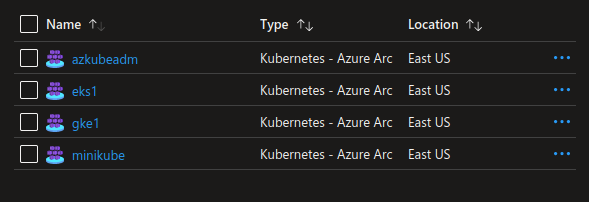
yumemaru@azure:~$ az connectedk8s list | jq .[2].name
"gke1"
yumemaru@azure:~$ az connectedk8s list | jq .[2]
{
"agentPublicKeyCertificate": "",
"agentVersion": "1.8.14",
"azureHybridBenefit": "NotApplicable",
"connectivityStatus": "Connected",
"distribution": "gke",
"distributionVersion": null,
"id": "/subscriptions/00000000-0000-0000-0000-000000000000/resourceGroups/arcdemo/providers/Microsoft.Kubernetes/connectedClusters/gke1",
"identity": {
"principalId": "00000000-0000-0000-0000-000000000000",
"tenantId": "00000000-0000-0000-0000-000000000000",
"type": "SystemAssigned"
},
"infrastructure": "gcp",
"kubernetesVersion": "1.24.5-gke.600",
"lastConnectivityTime": "2022-12-13T13:59:37.472000+00:00",
"location": "eastus",
"managedIdentityCertificateExpirationTime": "2023-03-13T10:33:00+00:00",
"miscellaneousProperties": null,
"name": "gke1",
"offering": null,
"privateLinkScopeResourceId": null,
"privateLinkState": "Disabled",
"provisioningState": "Succeeded",
"resourceGroup": "arcdemo",
"systemData": {
"createdAt": "2022-12-13T10:38:29.776311+00:00",
"createdBy": "david@teknews.cloud",
"createdByType": "User",
"lastModifiedAt": "2022-12-13T14:15:06.703912+00:00",
"lastModifiedBy": "64b12d6e-6549-484c-8cc6-6281839ba394",
"lastModifiedByType": "Application"
},
"tags": {},
"totalCoreCount": 6,
"totalNodeCount": 3,
"type": "microsoft.kubernetes/connectedclusters"
}
Under the hood, the az connectedk8s connect is actually deploying the agent through helm.
Using the helm list command, we can see the deployed chart:
We can see the azure-arc release and also the azurepolicy release.
yumemaru@local:~$ helm list -A
NAME NAMESPACE REVISION UPDATED STATUS CHART APP VERSION
azure-arc default 1 2022-12-13 11:39:07.233181548 +0100 CET deployed azure-arc-k8sagents-1.8.14 1.0
azurepolicy kube-system 2 2022-12-13 10:54:30.763188969 +0000 UTC deployed azure-policy-extension-arc-clusters-1.4.0 1
Funny thing, the release is in the default namespace, but if we look at the details of the release we can see that the target namespace is not the default namespace:
# Source: azure-arc-k8sagents/templates/namespace.yaml
apiVersion: v1
kind: Namespace
metadata:
name: azure-arc
labels:
control-plane: "true"
admission.policy.azure.com/ignore: "true"
Knowing that, we can have a look in the azure-arc namespace:
yumemaru@local:~$ k get all -n azure-arc
NAME READY STATUS RESTARTS AGE
pod/cluster-metadata-operator-79f6ff784-s6c5k 2/2 Running 0 27m
pod/clusterconnect-agent-5b888b7dd-5g98q 3/3 Running 0 27m
pod/clusteridentityoperator-5f5bd96dbf-mddcc 2/2 Running 0 27m
pod/config-agent-6fbd7cc7bb-vgjh5 2/2 Running 0 27m
pod/controller-manager-5b9bf8b674-t99bw 2/2 Running 0 27m
pod/extension-manager-7c8764b4dc-65254 2/2 Running 0 27m
pod/flux-logs-agent-74cc65d666-92nr2 1/1 Running 0 27m
pod/kube-aad-proxy-587dc6f549-lfhmg 2/2 Running 0 27m
pod/metrics-agent-b9db6f7db-8brgx 2/2 Running 0 27m
pod/resource-sync-agent-5c8f9bc979-bhqzh 2/2 Running 0 27m
NAME TYPE CLUSTER-IP EXTERNAL-IP PORT(S) AGE
service/flux-logs-agent ClusterIP 10.39.248.220 <none> 80/TCP 27m
service/kube-aad-proxy ClusterIP 10.39.246.84 <none> 443/TCP,8080/TCP 27m
NAME READY UP-TO-DATE AVAILABLE AGE
deployment.apps/cluster-metadata-operator 1/1 1 1 27m
deployment.apps/clusterconnect-agent 1/1 1 1 27m
deployment.apps/clusteridentityoperator 1/1 1 1 27m
deployment.apps/config-agent 1/1 1 1 27m
deployment.apps/controller-manager 1/1 1 1 27m
deployment.apps/extension-manager 1/1 1 1 27m
deployment.apps/flux-logs-agent 1/1 1 1 27m
deployment.apps/kube-aad-proxy 1/1 1 1 27m
deployment.apps/metrics-agent 1/1 1 1 27m
deployment.apps/resource-sync-agent 1/1 1 1 27m
NAME DESIRED CURRENT READY AGE
replicaset.apps/cluster-metadata-operator-79f6ff784 1 1 1 27m
replicaset.apps/clusterconnect-agent-5b888b7dd 1 1 1 27m
replicaset.apps/clusteridentityoperator-5f5bd96dbf 1 1 1 27m
replicaset.apps/config-agent-6fbd7cc7bb 1 1 1 27m
replicaset.apps/controller-manager-5b9bf8b674 1 1 1 27m
replicaset.apps/extension-manager-7c8764b4dc 1 1 1 27m
replicaset.apps/flux-logs-agent-74cc65d666 1 1 1 27m
replicaset.apps/kube-aad-proxy-587dc6f549 1 1 1 27m
replicaset.apps/metrics-agent-b9db6f7db 1 1 1 27m
replicaset.apps/resource-sync-agent-5c8f9bc979 1 1 1 27m
Visible in the output are the deployments for clusterconnect-agent, but also other interesting part such as the kube-aad-proxy, which for instance relies on the OSS project Guard.
I did not find as much details in the documentation as I would like, but I guess It’s Ok because the idea is that It is a managed deployment from the Azure Arc perspective. If you read throughly though, you should find (in the AKS documentation) that Guard logs are related to Azure Active Directory integration.
Ok that was all for the onboarding. Let’s look another cluster to onboard.
2.3. Onboarding an EKS cluster
In this rather short part, we will carry on with the On boarding, with an EKS cluster.
The process is actually the same. However, there is an unexpected addition due to the nature of the EKS architecture.
Indeed, we can see the EC2 instances used by the EKS cluster as nodes on boarded as Arc enabled servers:

That’s all for the on boarding part, let’s have a look from an Azure Ops perspective.
3. What the Azure Ops can do
Once the cluster is on boarded, what can the ops can do?
Well first the clusters are visible on the Azure portal. Also, It is possible to interact with those clusters from the Azure portal as described on the schema in the previous part. We saw that the onboading is deploying Helm charts under the hood.
We can add additional features on connected clusters through extensions and the az cli command az k8s-extension create.
Available extensions are:
| Extension | Description |
|---|---|
| Azure Monitor for containers | Provides visibility into the performance of workloads deployed on the Kubernetes cluster. Collects memory and CPU utilization metrics from controllers, nodes, and containers. |
| Azure Policy | Azure Policy extends Gatekeeper, an admission controller webhook for Open Policy Agent (OPA), to apply at-scale enforcements and safeguards on your clusters in a centralized, consistent manner. |
| Azure Key Vault Secrets Provider | The Azure Key Vault Provider for Secrets Store CSI Driver allows for the integration of Azure Key Vault as a secrets store with a Kubernetes cluster via a CSI volume. |
| Microsoft Defender for Cloud | Gathers information related to security like audit log data from the Kubernetes cluster. Provides recommendations and threat alerts based on gathered data. |
| Azure Arc-enabled Open Service Mesh | Deploys Open Service Mesh on the cluster and enables capabilities like mTLS security, fine grained access control, traffic shifting, monitoring with Azure Monitor or with open source add-ons of Prometheus and Grafana, tracing with Jaeger, integration with external certification management solution. |
| Flux (GitOps) | Use GitOps with Flux to manage cluster configuration and application deployment. |
| Dapr extension for Azure Kubernetes Service (AKS) and Arc-enabled Kubernetes | Eliminates the overhead of downloading Dapr tooling and manually installing and managing the runtime on your clusters. |
Without surprise, we have again Helm charts deployed under the hoods. It’s worthy of note that, as for the connected agent helm cart, the target namespace of the associated kubernetes resources is not necessarily the same as the one in which we find the release information.
Also, looking at the extension, we can see a trend here.
Indeed, everything is aimed to help Azure Ops to manage from Azure the connected clusters. Which makes sense when thinking about the Arc concepts. that being said, let’s have a look at a few of those extensions.
3.1. Azure Monitor for containers extension
To deploy the Azure Monitor extension, as for all the extension as a matter of facts, we use the command az k8s-extension create:
yumemaru@azure:~$ az k8s-extension create --name azuremonitor-containers --cluster-name gke1 --cluster-type connectedClusters --resource-group arcdemo --extension-type Microsoft.AzureMonitor.Containers --configuration-settings logAnalyticsWorkspaceResourceID='/subscriptions/00000000-0000-0000-0000-000000000000/resourceGroups/rsg-fr-poc-taflog/providers/Microsoft.OperationalInsights/workspaces/law-fr-poc-taflog16e85b36'
Ignoring name, release-namespace and scope parameters since microsoft.azuremonitor.containers only supports cluster scope and single instance of this extension.
Defaulting to extension name 'azuremonitor-containers' and release-namespace 'azuremonitor-containers'
{
"aksAssignedIdentity": null,
"autoUpgradeMinorVersion": true,
"configurationProtectedSettings": {
"amalogs.secret.key": "",
"amalogs.secret.wsid": "",
"omsagent.secret.key": "",
"omsagent.secret.wsid": ""
},
"configurationSettings": {
"logAnalyticsWorkspaceResourceID": "/subscriptions/00000000-0000-0000-0000-000000000000/resourceGroups/rsg-fr-poc-taflog/providers/Microsoft.OperationalInsights/workspaces/law-fr-poc-taflog16e85b36"
},
"customLocationSettings": null,
"errorInfo": null,
"extensionType": "microsoft.azuremonitor.containers",
"id": "/subscriptions/00000000-0000-0000-0000-000000000000/resourceGroups/arcdemo/providers/Microsoft.Kubernetes/connectedClusters/gke1/providers/Microsoft.KubernetesConfiguration/extensions/azuremonitor-containers",
"identity": {
"principalId": "00000000-0000-0000-0000-000000000000",
"tenantId": null,
"type": "SystemAssigned"
},
"installedVersion": null,
"name": "azuremonitor-containers",
"packageUri": null,
"provisioningState": "Succeeded",
"releaseTrain": "Stable",
"resourceGroup": "arcdemo",
"scope": {
"cluster": {
"releaseNamespace": "azuremonitor-containers"
},
"namespace": null
},
"statuses": [],
"systemData": {
"createdAt": "2022-12-13T12:50:25.023953+00:00",
"createdBy": null,
"createdByType": null,
"lastModifiedAt": "2022-12-13T12:50:25.023953+00:00",
"lastModifiedBy": null,
"lastModifiedByType": null
},
"type": "Microsoft.KubernetesConfiguration/extensions",
"version": "3.0.0"
}
As discussed, under the hood we have a Helm chart extension on which we can get information with the helm get command.
A sample of this command output is displayed below:
# Source: azuremonitor-containers/templates/ama-logs-rbac.yaml
apiVersion: v1
kind: ServiceAccount
metadata:
name: ama-logs
namespace: kube-system
labels:
chart: azuremonitor-containers-3.0.0
release: azuremonitor-containers
heritage: Helm
#===================Truncated==============================
---
# Source: azuremonitor-containers/templates/ama-logs-arc-k8s-crd.yaml
apiVersion: clusterconfig.azure.com/v1beta1
kind: AzureClusterIdentityRequest
metadata:
name: container-insights-clusteridentityrequest
namespace: azure-arc
spec:
audience: https://monitor.azure.com/
resourceId: azuremonitor-containers
---
# Source: azuremonitor-containers/templates/ama-logs-arc-k8s-crd.yaml
#extension model
apiVersion: clusterconfig.azure.com/v1beta1
kind: AzureExtensionIdentity
metadata:
name: azuremonitor-containers
namespace: azure-arc
spec:
serviceAccounts:
- name: ama-logs
namespace: kube-system
tokenNamespace: azure-arc
Note that this time, everything is deployed in the kube-system namespace, and also the CRDs that are added by the extension.
With this extension, Azure Ops trained to Azure Monitor can get views of what happened on connected cluster, the same wya that a k8s ops usually gets view with the popular monitoring stacks (prometheus grafana…)

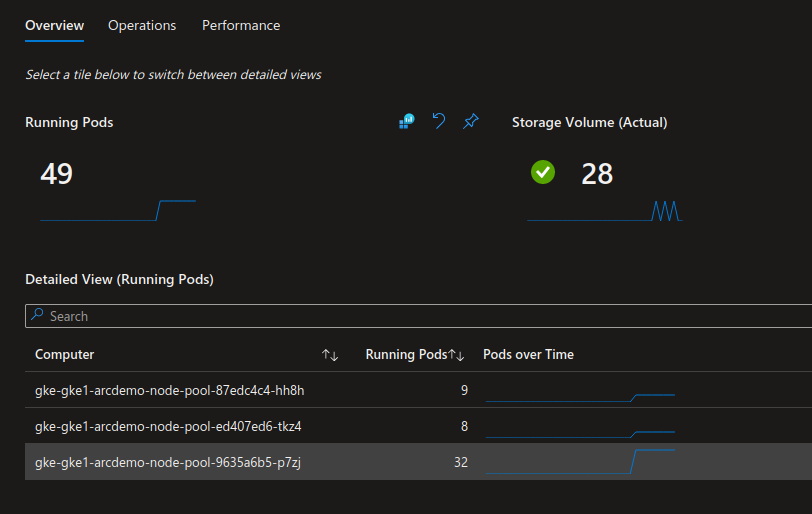
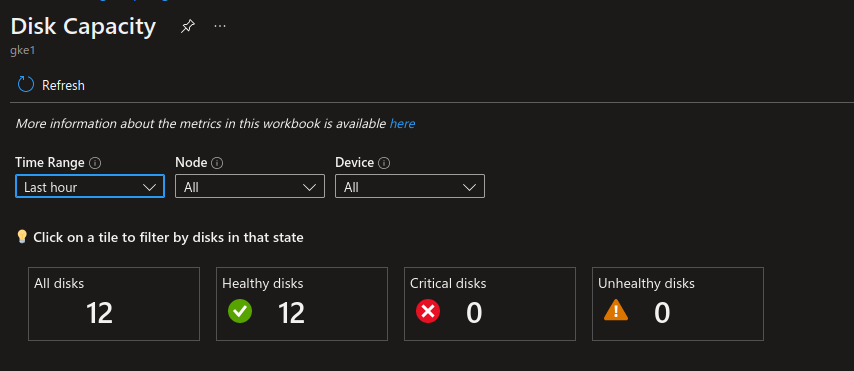
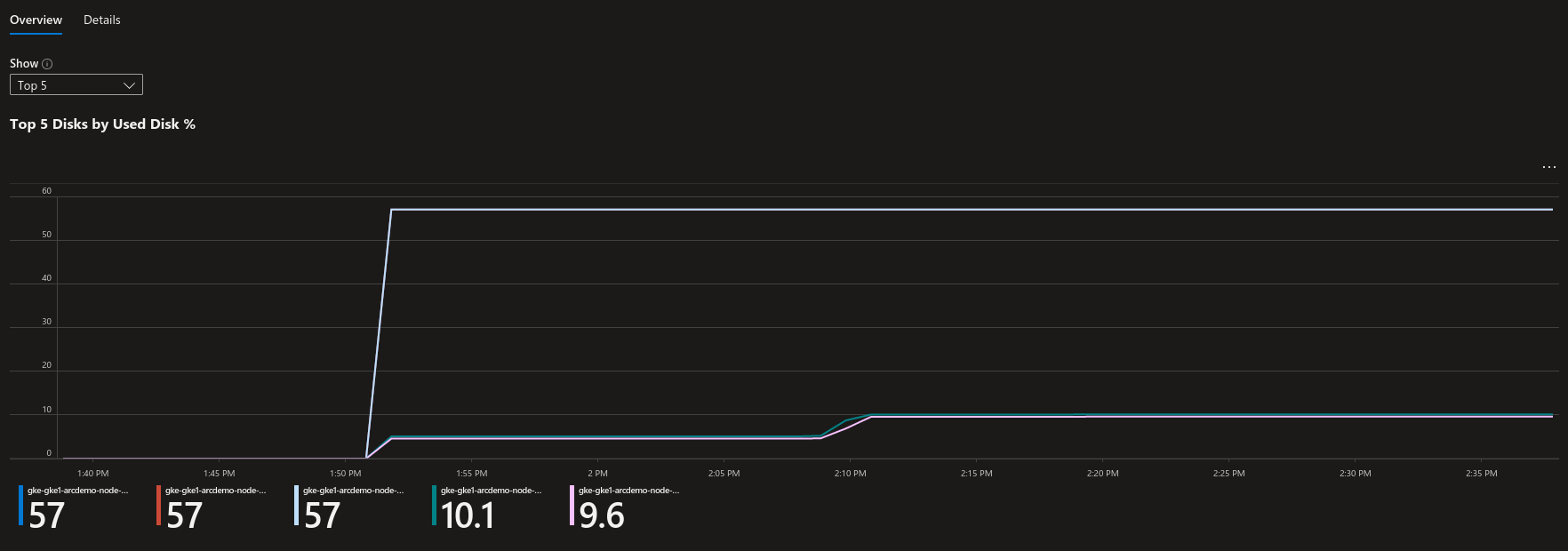
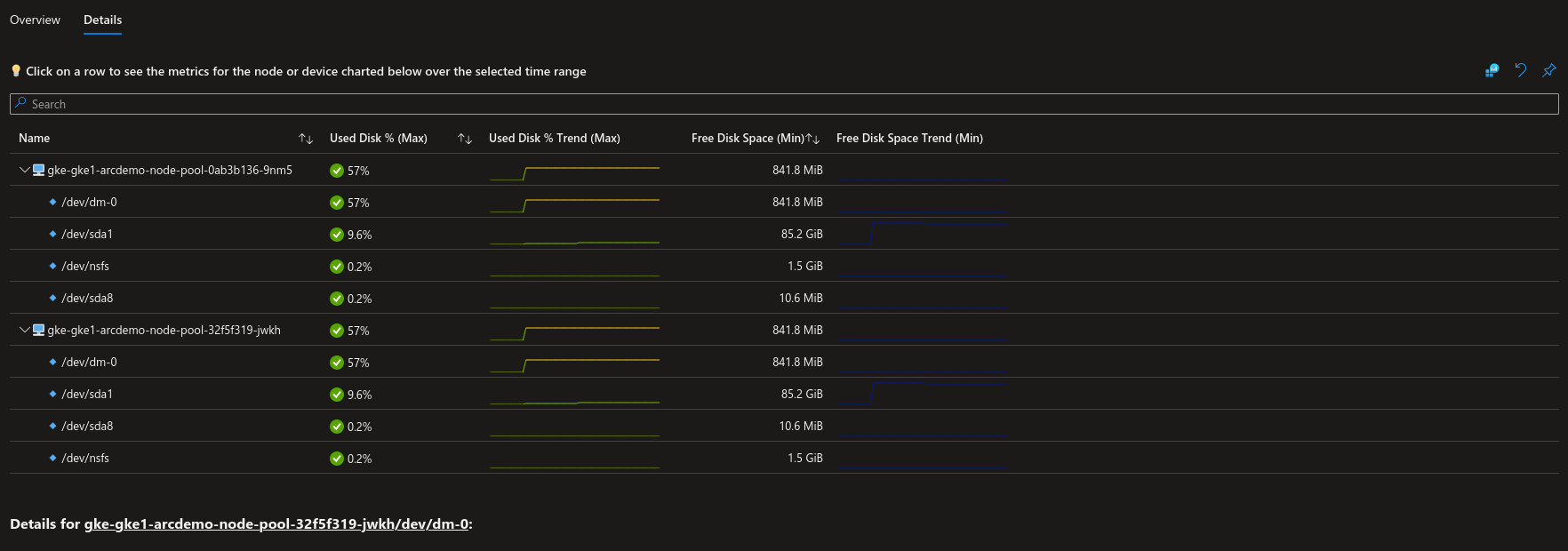
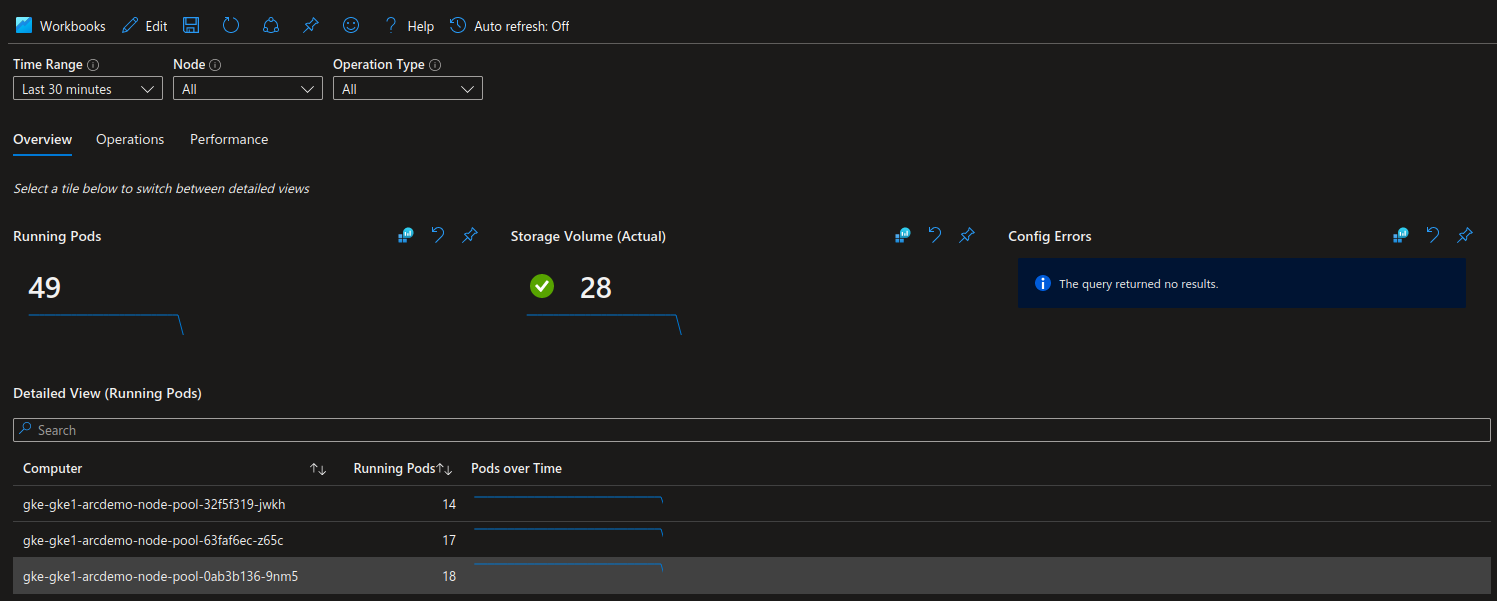
3.2. Azure Defender for Cloud extension
Another tool from the Azure Ops box is Defender for Cloud. As expected, this extension gives that capability of having a connection to Azure CSPM. While Monitoring may not necessarily be a target for experienced Kubernetes Ops, SecOps in Azure definitly have interest to get all Kubernetes assets in their CSPM’s dashboard.
Note that we get the target namespace mdcfrom the az k8s-extension create command:
yumemaru@azure:~$ az k8s-extension create --name microsoft.azuredefender.kubernetes --cluster-name gke1 --cluster-type connectedClusters --resource-group arcdemo --extension-type microsoft.azuredefender.kubernetes
Ignoring name, release-namespace and scope parameters since microsoft.azuredefender.kubernetes only supports cluster scope and single instance of this extension.
Defaulting to extension name 'microsoft.azuredefender.kubernetes' and release-namespace 'mdc'
{
"aksAssignedIdentity": null,
"autoUpgradeMinorVersion": true,
"configurationProtectedSettings": {
"amalogs.secret.key": "",
"amalogs.secret.wsid": "",
"omsagent.secret.key": "",
"omsagent.secret.wsid": ""
},
"configurationSettings": {
"logAnalyticsWorkspaceResourceID": "/subscriptions/00000000-0000-0000-0000-000000000000/resourcegroups/defaultresourcegroup-eus/providers/microsoft.operationalinsights/workspaces/defaultworkspace-00000000-0000-0000-0000-000000000000-eus"
},
"customLocationSettings": null,
"errorInfo": null,
"extensionType": "microsoft.azuredefender.kubernetes",
"id": "/subscriptions/00000000-0000-0000-0000-000000000000/resourceGroups/arcdemo/providers/Microsoft.Kubernetes/connectedClusters/gke1/providers/Microsoft.KubernetesConfiguration/extensions/microsoft.azuredefender.kubernetes",
"identity": {
"principalId": "6aee9724-4d59-48a0-b077-ac831f29e303",
"tenantId": null,
"type": "SystemAssigned"
},
"installedVersion": null,
"name": "microsoft.azuredefender.kubernetes",
"packageUri": null,
"provisioningState": "Succeeded",
"releaseTrain": "Stable",
"resourceGroup": "arcdemo",
"scope": {
"cluster": {
"releaseNamespace": "mdc"
},
"namespace": null
},
"statuses": [],
"systemData": {
"createdAt": "2022-12-13T13:07:52.219160+00:00",
"createdBy": null,
"createdByType": null,
"lastModifiedAt": "2022-12-13T13:07:52.219160+00:00",
"lastModifiedBy": null,
"lastModifiedByType": null
},
"type": "Microsoft.KubernetesConfiguration/extensions",
"version": "0.7.8"
}
Defender for Cloud and specifically hybrid aspects of CSPM is a full topic in itself, so let’s keep the deep dive for another time. Let’s just say that with this installation and the Azure documentation, it’s easy to get started on CSPM for Arc enabled Kubernetes.
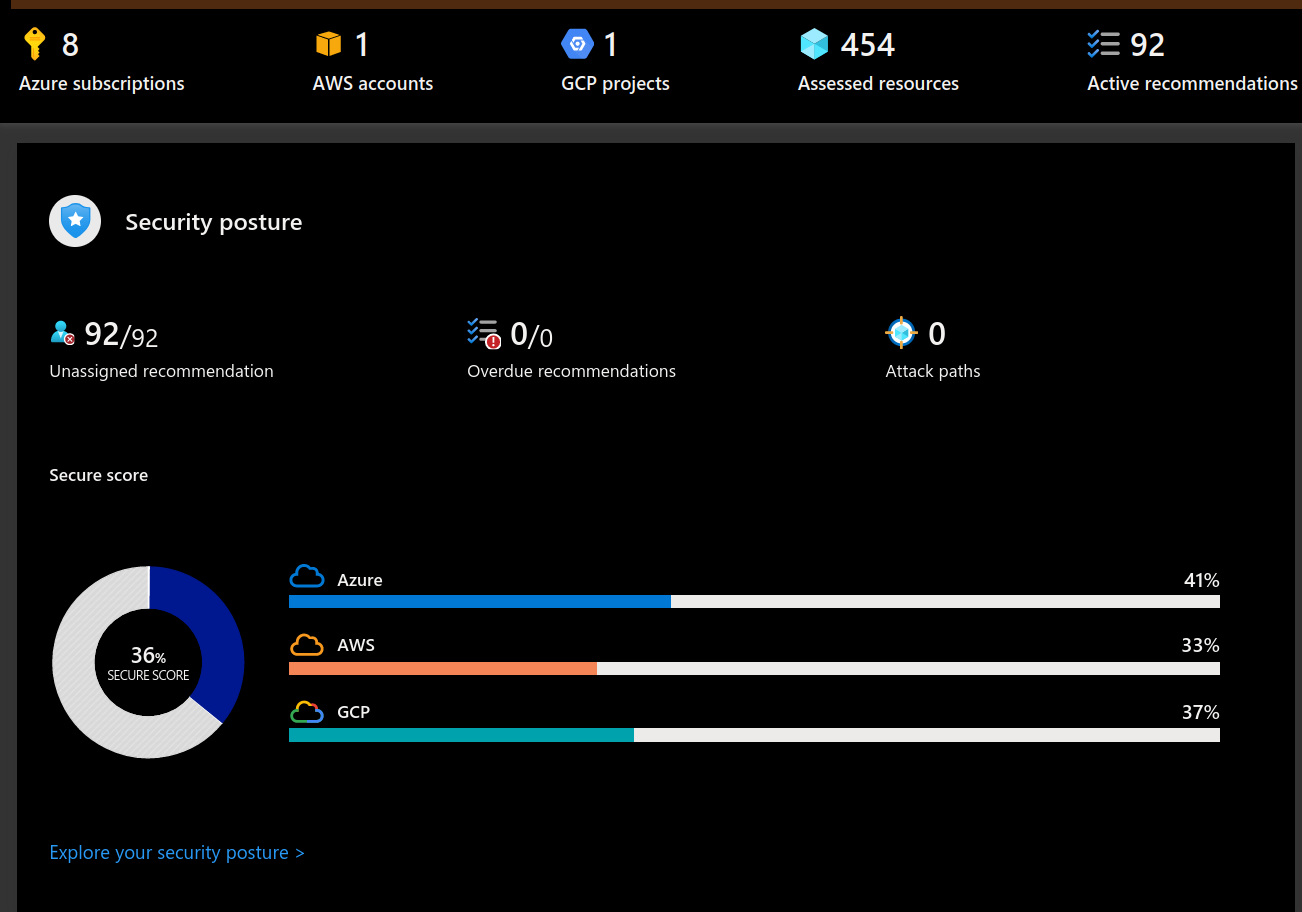
3.3. Azure Policy extension
Last in the extensions, but not list is the Azure Policy extension.
This allows a control from the Azure plan for connected cluster through OPA and the infamous rego language, mixed with the json language from the Azure policies. theres’s a gap in skill to adress before being efficient for the Azure Ops, not necessarily for the Kubernetes Ops already familiar with OPA.
In this specific case, I want to demonstrate the limit of the not officially supported kubernetes distribution version. Let’s consider a microk8s installation for let’s say a dev environment. It’s easy to install and the arc connection would allow to apply automatically, specifically with Azure Policy extension, enterprise guardrails.
But there may be a catch.
Below is a failed attempt to connect the microk8s cluster:

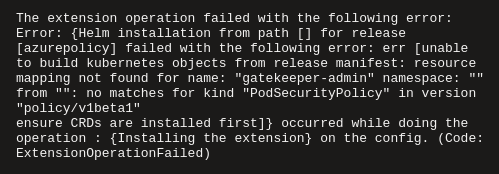
{
"code":"DeploymentFailed",
"message":"At least one resource deployment operation failed. Please list deployment operations for details. Please see https://aka.ms/DeployOperations for usage details.",
"details":
[
{
"code":"ExtensionOperationFailed",
"message":"The extension operation failed with the following error: Error: {Helm installation from path [] for release [azurepolicy] failed with the following error: err [unable to build kubernetes objects from release manifest: resource mapping not found for name: \"gatekeeper-admin\" namespace: \"\" from \"\": no matches for kind \"PodSecurityPolicy\" in version \"policy/v1beta1\"\nensure CRDs are installed first]} occurred while doing the operation : {Installing the extension} on the config."
}
]
}
As we can see, it failed, simply because of the version of the used API object.
In officially supported version, there’s a well known roadmap of the kubernetes version, and corollary, of the kubernetes API version.
but in our case, because we are in a 1.26 or something version, we do not have anymore the PodSecurityPolicy in version policy/v1beta1, hence the failure.
Hopefully, It will be updated when AKS is in version 1.26+.
3.4. Tunneling to connected cluster
There may be time when an Ops need to access a connected cluster.
But by default, as described in the architecture part, there are no incoming flows opened to allow the Ops to access. Except through the Arc agent.
And with the agent, there is a capability of tunneling that can be configured, and that would allow interaction with the API server of the connected cluster.
Azure Documentation described that more or less clearly. The less clear part, in my opinion, being the AAD integration. It should be known that the AAD integration is not available for other cloud managed Kubernetes such as EKS or GKE.
But that does not mean that we cannot tunnel through those cluster. Only that we need to rely on a service account and a token:
yumemaru@local:~$ k create sa arcdemo
serviceaccount/arcdemo created
yumemaru@local:~$ k create clusterrolebinding arcdemo-binding --clusterrole cluster-admin --serviceaccount default:demo
clusterrolebinding.rbac.authorization.k8s.io/arcdemo-binding created
yumemaru@local:~$ k create clusterrolebinding arcdemo-binding --clusterrole cluster-admin --serviceaccount default:arcdemo
clusterrolebinding.rbac.authorization.k8s.io/arcdemo-binding created
Note that the code snippet is using a way to permissive binding with the cluster-admin role.
A less permissive role coupled with the Azure portal native viewing capabilities would probably suffice and allow Ops to get enough information on the running workloads:
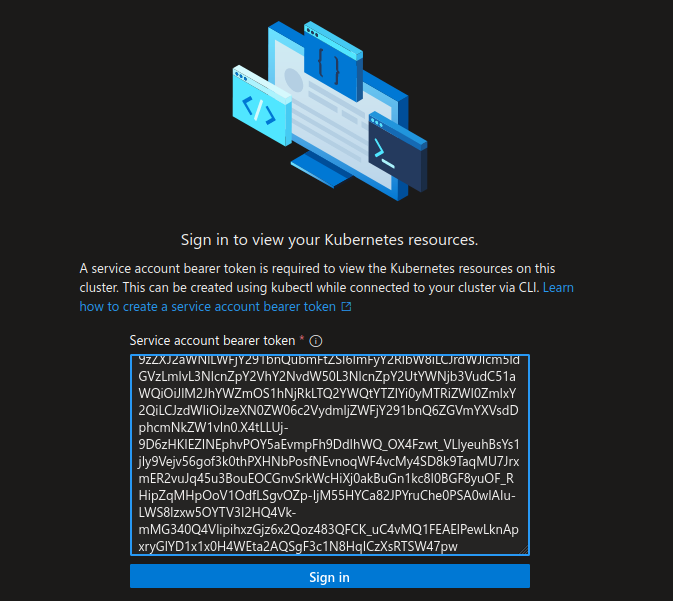
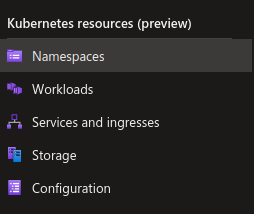

4. To conclude
That’s the end of this article.
From my opinion, Azure Arc, and specifically the Kubernetes extensions, is starting to be interesting. There is a(n easiest) path for Azure Ops that need to manage multi cloud, with the toolbox that are the connected clusters and their available extension. There’s still the question of the cost for logs in Kubernetes environment I wouyld guess, and also room for evolution with the managed Prometheus and Grafana stacks that recently landed in the Azure landscape.
I’ll have things to look at quite soon I think ^^.